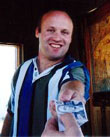|
|
 
|
|
Author
|
Topic: Running a Drive In
|
|
|
Aaron Sisemore
Flaming Ribs beat Reeses Peanut Butter Cups any day!

Posts: 3061
From: Rockwall TX USA
Registered: Sep 1999
|
 posted 03-03-2001 11:14 PM
posted 03-03-2001 11:14 PM




Well there are several differences in how they run besides the obvious 'indoor vs outdoor' part:-Most if not all drive-ins run double-feature programs, usually both from the same distributor. -Drive-ins can charge by either the individual or by the carload -Consession-wise, the drive-in offers almost limitless possibilities, I have seen drive-ins offer everything from popcorn and soda and hot dogs to burgers, soups, various fried items, pizza, nachos, deli sandwiches, chili, and other unique food items sundry items such as cigarettes, lighters, insect repellent, condoms(!), T-shirts, soundtrack albums/tapes (back in the pre-CD days), the list could go on for days...  -Staffing is a bit different in an outdoor situation, the box offices in many D/Is are usually remote from the main concession building so a dedicated box person would need to be on duty, and if the place does well enough the concession staqnd would probably need to be heavily manned as well. Security might be necessarym, especially if the D/I is located in a high-crime area or there is a history of mischief among the younger people that attend the shows there. Field maintenance is another issue, especially if you still run speakers, as they will always need servicing. Also cleaning the field will have to be done every day to control the garbage and critter problems. Booth-wise, most standard projection equipment is useable in a drive-in, You will need to get the largest wattage xenon you can afford for a lamp, and the best lenses you can get your hands on for the maximum brightness on screen. Sound can be done with AM or FM radio as well as the old in-car speaker systems, You can even have stereo sound with some of the FM systems now if you add a stereo processor!
Aaron
|
|
|
|
|
|
John Pytlak
Film God

Posts: 9987
From: Rochester, NY 14650-1922
Registered: Jan 2000
|
 posted 03-07-2001 12:56 PM
posted 03-07-2001 12:56 PM





I agree with Darryl that reel-to-reel operation would have advantages for a single or two screen drive-in, especially regarding the programming flexibility. But it does entail the added cost of two projectors/lamps per screen as compared to a single projector and platter.Keeping the booth and film clean is especially important in a drive-in. Lots of gritty dirt flying about, so use an on-line film cleaner to keep the film clean. A sealed or tile floor will be easier to keep clean. Use a door mat to clean shoes before entering. Use a vacuum cleaner and damp mopping to keep the floor and work surfaces clean. Fortunately, Kodak VISION print film has a conductive antistatic coating on the base side to greatly reduce static attraction of dirt particles to the film. A freshly painted screen makes a world of difference for a bright image. For a matte white painted screen, figure 5 watts per square foot of screen area if you hope to get anywhere near the SMPTE aim of 16 footlamberts. Unfortunately, even a 6000 watt lamp will be lucky to light a 40x96 foot painted screen to only 5 footlamberts, so SMPTE Recommended Practice RP12 allows some flexibility for drive-ins. Bugs and critters can be a problem too. In my drive-in days, rats were a constant problem on late night lot patrols, and I chased a few out of the booth too. Keep the lot clean and the dumpsters sealed. ------------------
John P. Pytlak, Senior Technical Specialist
Worldwide Technical Services, Entertainment Imaging
Eastman Kodak Company
Research Labs, Building 69, Room 7419
Rochester, New York, 14650-1922 USA
Tel: 716-477-5325 Cell: 716-781-4036 Fax: 716-722-7243
E-Mail: john.pytlak@kodak.com
Web site: http://www.kodak.com/go/motion
|
|
|
|
John Pytlak
Film God

Posts: 9987
From: Rochester, NY 14650-1922
Registered: Jan 2000
|
 posted 03-07-2001 03:34 PM
posted 03-07-2001 03:34 PM





The 5 watts per square foot is a "rule of thumb" for lighting up a matte white (gain = 1.0) screen, and will vary with the efficiency of the system (e.g., shutter type, mirror collection efficiency, lens f/number, losses in port glass, alignment, etc.).In general, light output will be proportional to lamp power (watts), but as the lamp gets really large, it is more difficult to focus the larger plasma arc at the 35mm film aperture efficiently. The "flat" 1.85:1 format is less efficient than the "scope" format, because the (generally) circular beam of light from the lamphouse is "cropped" more by the smaller aperture:
http://www.kodak.com/US/en/motion/newsletters/reel/february97/pytlak.shtml ------------------
John P. Pytlak, Senior Technical Specialist
Worldwide Technical Services, Entertainment Imaging
Eastman Kodak Company
Research Labs, Building 69, Room 7419
Rochester, New York, 14650-1922 USA
Tel: 716-477-5325 Cell: 716-781-4036 Fax: 716-722-7243
E-Mail: john.pytlak@kodak.com
Web site: http://www.kodak.com/go/motion
|
|
|
|
All times are Central (GMT -6:00)
|
|
Powered by Infopop Corporation
UBB.classicTM
6.3.1.2
The Film-Tech Forums are designed for various members related to the cinema industry to express their opinions, viewpoints and testimonials on various products, services and events based upon speculation, personal knowledge and factual information through use, therefore all views represented here allow no liability upon the publishers of this web site and the owners of said views assume no liability for any ill will resulting from these postings. The posts made here are for educational as well as entertainment purposes and as such anyone viewing this portion of the website must accept these views as statements of the author of that opinion
and agrees to release the authors from any and all liability.
|

 Home
Home
 Products
Products
 Store
Store
 Forum
Forum
 Warehouse
Warehouse
 Contact Us
Contact Us




 Printer-friendly view of this topic
Printer-friendly view of this topic














